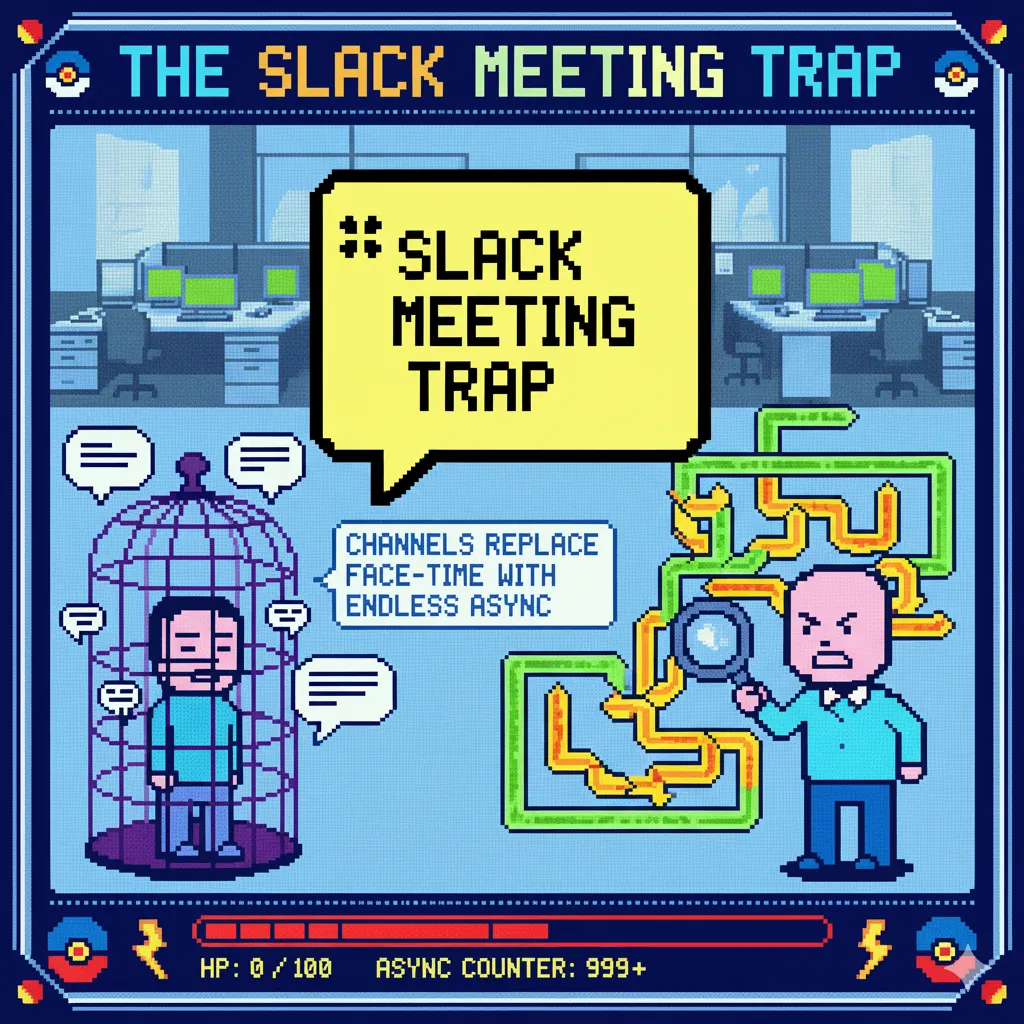The Slack Meeting Trap: How Channels Replace Face-Time With Endless Async
Day three of the #pricing-strategy discussion. Seventeen participants, forty-two messages, zero decisions. What should have been a 30-minute meeting became a week-long thread that solved nothing.

The pendulum swing
The meeting backlash was justified. Calendar Tetris, pointless status updates, discussions that could have been emails. Remote work made it worse — Zoom fatigue on top of meeting fatigue.
Slack felt like salvation. Asynchronous communication! Work at your own pace! No more calendar tyranny!
Then reality hit. Some decisions need the bandwidth of live conversation. Some problems require back-and-forth that takes minutes in person and days in text.
Why async discussions stall
Slack conversations lack forcing functions. Meetings have endpoints — someone eventually says "let's wrap up" and forces a conclusion. Slack threads just… fade.
Without shared presence, context gets lost between messages. Person A responds to point 3, Person B references point 1, Person C introduces point 7. The thread becomes a conversation where nobody's talking to the same person.
Add time zones, and async becomes a cycle of misaligned responses that never converge on decisions.
The complexity threshold
Simple updates work great async. Complex decisions don't. The more variables, stakeholders, and trade-offs involved, the more real-time discussion helps.
Teams try to force nuanced strategy conversations into Slack because they're afraid to schedule another meeting. Result: important decisions get either delayed indefinitely or made with incomplete input.
The tool shapes the decision quality.
What gets lost in translation
Facial expressions, tone, energy, interruptions — they all carry information. When someone's idea sparks excitement, you see it immediately in a room. In Slack, enthusiasm gets flattened into "sounds good 👍" three hours later.
The informal sidebar conversation that clarifies confusion? Doesn't happen. The moment when someone's expression shows they disagree but haven't voiced it yet? Lost.
Context collapse kills nuanced discussion.
The hybrid sweet spot
Smart teams use both. Slack for updates, coordination, and simple decisions. Meetings for complex discussions, brainstorming, and decisions that need real-time energy.
The decision criteria: If the outcome depends on quick back-and-forth, group thinking, or reading the room, schedule 30 minutes. If it's information sharing or simple binary choices, keep it async.
Reclaiming meeting legitimacy
Meetings aren't inherently bad. Bad meetings are bad. Well-run meetings with clear agendas, specific outcomes, and engaged participants solve problems that async can't touch.
The goal isn't zero meetings. It's intentional meetings.
What good hybrid looks like
Monday's product discussion happens live. Fifteen minutes of rapid-fire questions and answers settles the direction. Follow-up details and next steps get captured in Slack.
Wednesday's client feedback review starts with a Slack summary, continues in a focused 20-minute discussion, and concludes with clear action items posted back to the channel.
Friday's retrospective uses Slack for collecting input, live discussion for working through conflicts, and documented decisions for future reference.
The real productivity gain
Productivity isn't about eliminating meetings. It's about matching communication modes to communication needs. Complex decisions made quickly instead of simple decisions made slowly.
When teams stop forcing every discussion into async, both meetings and Slack conversations get more effective.
Beyond the false choice
The meeting vs. Slack debate misses the point. Different problems need different solutions. The art is knowing when to shift from one to the other.
Text for coordination. Voice for collaboration. Both for results.
For teams ready to optimize their communication mix instead of defaulting to endless async, Float AI helps identify when Slack discussions would benefit from real-time conversation — before they turn into week-long threads that go nowhere.